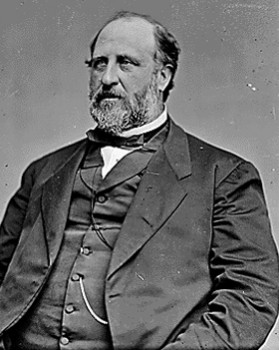It has been estimated that during his reign of corruption, William Magear “Boss” Tweed (1823–1878), the “Tiger of Tammany,” and his political cronies stole $200 million (the equivalent of about $3.5 billion in today’s money) from the citizens of New York. Tweed, serving as New York State Senator, Democratic County Chairman, School Commissioner, Deputy Street Commissioner and President of the Board of Supervisors, had untold schemes to put public money into his own pockets and those of his friends. But his greatest single thievery project was the New York County Courthouse on Chamber Street, described at the time as “The House that Tweed Build.”
In 1858, the New York State Legislature approved “a sum not exceeding $250,000” (close to $6 million today) for the construction and furnishing of New York City’s courthouse. This was a substantial sum in an era when school teachers were making only $300 per year. But that appropriation was nothing compared to what the Tweed Ring had in mind for their grandest exercise in graft. In an era in which all of the land for Central Park cost New York City $5 million, and the elaborate St. Patrick’s Cathedral cost $2 million to build, the Tweed Courthouse wound up costing New York’s taxpayers $12 million (equivalent to about $200 million today). More money was spent to build the Tweed Courthouse than was spent to construct the United States Capitol. In fact, the Courthouse was the costliest public building that had yet been built in the United States.
It is no mystery why the Tweed Courthouse cost so much to build: bills were wildly inflated in order to provide generous sums for kickbacks. Billings for plaster work by Andrew J. Garvey, the grand marshal of Tammany Hall, who was dubbed the “Prince of Plasterers,” were $3 million; much of that was for Garvey’s repairs of his own work. The final expenditure for brooms for the courthouse, $250,000, matched the total originally budgeted for the entire building. Enough carpet was ordered (close to $5 million worth) to cover all of City Hall Park three times, and many of the companies billing for carpeting did not even exist. Thermometers for the courthouse cost $7,500. Three tables and four chairs were billed at $179,729. Over $1 million was paid for plumbing work. The marble for the courthouse was purchased from a quarry in Massachusetts that Tweed himself just happened to have recently purchased; quarrying that marble cost more than it had cost to build an entire courthouse in Brooklyn.
After a campaign led by The New York Times and cartoonist Thomas Nast of Harper’s Weekly, Tweed was arrested for his crimes in 1871, and the Tweed Ring was finally forced from power. Tweed went to trial in November, 1873; ironically, his trial was held in the still-incomplete courthouse. Tweed was convicted of 204 counts, but he escaped from custody and fled to Spain, only to be recaptured by Spanish officials who, relying on a Nast cartoon, recognized him. Tweed was brought back to New York City, spent some time in prison, and died in 1878.
–from Brooklyn’s Green-Wood Cemetery, New York’s Buried Treasure by Jeffrey I. Richman
